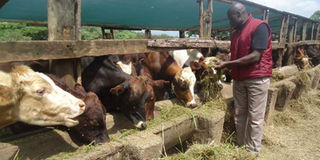Premium
Tired of Friesian? Red Poll and Boran perform just as well

Thomas Onono feeding beef animals at Mazao Farm in Kisumu. PHOTO | NATION
What you need to know:
- The Red Poll has white patches on the tail and udder, with the body being deep red in colour. It is a dual-purpose cattle and does not have horns.
- The Boran cattle, on the other hand, comes in white, red or black colours. It is an indigenous breed that has the ability to walk for long distances in search of water and feeds. Both animals are hardy.
- A farmer who keeps dairy cows is likely to get return on investment faster as compared to beef production, which might take three years.
The about 50 steers stand in a neat line as they munch grass from a feeding trough, almost in sync.
Thomas Onono, the farm’s deputy manager, is dressed in a red jacket, khaki trouser and black shoes, and he stands near them watching as they feed on the grass that is mixed with juice extracted from jaggery.
The beef cattle are at the zero-grazing unit of the farm known as Mazao Yetu in Koru, Kisumu County, for fattening.
“We mainly keep Boran and Red Poll cows and their crosses for meat and milk. We have 110 Borans, 68 Boran/Red Poll crosses, 85 pure Red Poll and 60 Jersey,” says Onono.
The Red Poll has white patches on the tail and udder, with the body being deep red in colour. It is a dual-purpose cattle and does not have horns.
The Boran cattle, on the other hand, comes in white, red or black colours. It is an indigenous breed that has the ability to walk for long distances in search of water and feeds. Both animals are hardy.
Onono says Koru is not the typical Boran grazing environment as the area receives high rainfall of 1,650mm annually and has steep hills.
“The success of our Boran herd, however, attests to the adaptability of the breed to produce in very varied conditions. The breed can tolerate harsh rangeland conditions and has good quality beef, the reason we keep it.”
STUD BOOK
Similarly, he says the Red Poll produces excellent beef and substantial amounts of milk. The bone to meat ratio is high and they mature faster.
“We keep the Boran cattle specifically for beef while the Red Poll and Jersey for milk. Both the breeds can produce between 16 and 28 litres of milk a day,” says Onono, adding they stopped keeping Friesians.
According to him, the western Kenya environment does not favour Friesian because it is a heavy feeder and it suffers heat stress compared to the Red Poll and Jersey.
On average, the firm collects 900 litres of milk per day from about 90 cows that are at different stages of lactation and sell it, together with the beef, through Fairleigh Farm shops in Kisumu, which they own.
The milk is further processed into cheese, butter, yoghurt and ice cream. A litre of fresh milk goes for Sh80 while a 250g bar of ice cream goes for Sh100.
For beef production, they sell the animals when they are 400kg at an average of Sh200,000.
The farm’s Boran cows are regularly inspected by the Boran Cattle Breeders Society and are registered with the Kenya Stud Book.
“We register the animals to maintain high standards. As a farmer, you always want to know you are keeping the best. The registration helps in benchmarking animal standards and market,” says Onono.
Further, registration adds value of an animal during sale.
“When you want to sell a bull that is not registered, price ranges between Sh100,000 and Sh150,000. For a registered animal, the pure breed bull goes from Sh200,000 to Sh250,000.”
The cattle are fed on grass, jaggery juice that is extracted from the sugarcane grown at the farm and 2kg of protein supplement each.
They are fed four times a day, in the morning, midday, afternoon and in the evening.
Prof Mathews Dida, a lecturer at Maseno University’s Department of Agriculture, says that jaggery juice, just like molasses has sugar that animals require.
“When you add jaggery juice to the dry matter, it raises the palatability besides being a source of energy.”
Jimmy Brooks, the managing director of the farm, says they started with a few cattle but increased the number over the years to the current over 1,000 cattle, 323 which are mature and the rest are calves. They keep them under zero-grazing and free-range systems.
QUICK RETURNS
“When I came here to work in 1983, we had 200 head of cattle. Today we have a maximum of 1,200. We select the best animals and do continuous breeding through artificial insemination or use bulls bought from other breeders.” Besides poor road network, fattening the animals is difficult because they mainly rely on grass, says Brooks of their challenges.
However, all has not been in vain. The farm has won at least two awards at the Livestock Breeders Show in 2011 and 2013 for their dual-purpose cows.
“We have won trophies for the Boran and Red Polls breed. We take our cattle for exhibitions mostly at Nairobi and Kisumu Agricultural Society of Kenya,” says Brooks.
David Mbakaya, a senior agronomist at Kenya Agriculture Research Institute, argues that a farmer who keeps dairy cows is likely to get return on investment faster as compared to beef production, which might take three years.
“For dairy farmers, one sells the milk and later the animals but for beef, you have to wait sometimes for three years to reap benefits. Keeping both animals can pay more.”




